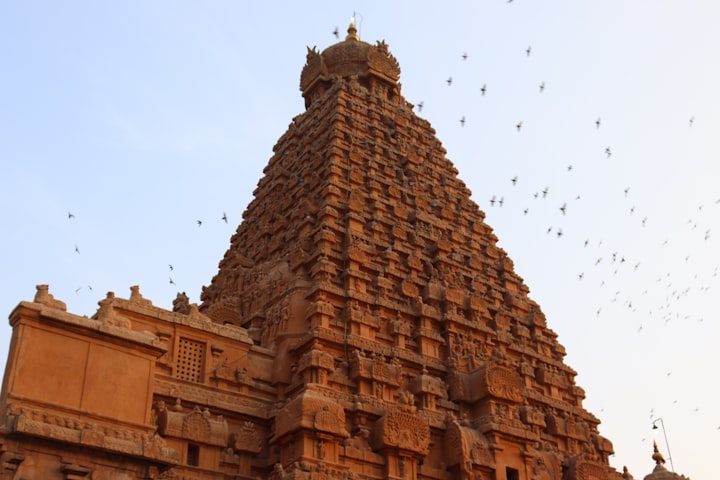
Thanjavur Temple, also known as Brihadeeswarar Temple or Peruvudaiyar Kovil, is a UNESCO World Heritage Site located in Thanjavur, Tamil Nadu, India. It was built during the 11th century under the reign of the Chola dynasty.
The temple is dedicated to Lord Shiva and is one of the largest and most famous temples in India. It features a towering 66-meter high vimana, or tower, made of granite, and is topped by a single stone carving of a large Nandi bull. The temple also has a massive courtyard, several pillared halls, and smaller shrines dedicated to other deities.
The temple is known for its intricate carvings, which adorn the walls and pillars of the temple. These carvings depict various scenes from Hindu mythology and everyday life, as well as intricate patterns and designs. The temple also has a large collection of bronze sculptures, including the famous dancing Nataraja.
The history of the Thanjavur Temple dates back to the 10th century when the Chola King Rajaraja I built the temple to celebrate his victory over his enemies. The temple was designed by the architect Kunjara Mallan Raja Raja Perunthachan, who is considered one of the greatest architects of the Chola dynasty.
The temple is famous for its architecture and is considered a masterpiece of Dravidian architecture. The temple is also known for its historical and cultural significance, as it is a symbol of the Chola dynasty's cultural and artistic achievements. The temple is a major pilgrimage site for Hindus and attracts millions of visitors every year.
Overall, Thanjavur Temple is an iconic temple that represents the rich cultural heritage of India and is a must-visit destination for anyone interested in Indian history, architecture, and religion.
THANJAVUR MUSUEM
The Thanjavur Palace Museum is a historical museum located in the Nayak Durbar Hall inside the Thanjavur Palace complex in Thanjavur, Tamil Nadu, India. The museum houses a vast collection of artifacts that offer a glimpse into the history, culture, and art of the Thanjavur region.
Some of the famous exhibits in the museum include:
Bronze and stone sculptures: The museum houses a large collection of bronze and stone sculptures dating back to the 9th century. These sculptures depict various Hindu gods and goddesses and are known for their intricate details and craftsmanship.
Paintings: The museum features a collection of paintings from the Nayak and Maratha period, including the famous Thanjavur paintings that are known for their use of vibrant colors and intricate detailing.
Musical instruments: The museum also houses a collection of musical instruments, including the veena, mridangam, and nagaswaram, which are an integral part of the music culture of South India.
Manuscripts: The museum has a collection of ancient manuscripts, including palm-leaf manuscripts and copper-plate inscriptions, that offer insights into the literary and historical traditions of the region.
Overall, the Thanjavur Palace Museum is a significant cultural and historical landmark that offers a glimpse into the rich heritage of Thanjavur. It is a must-visit destination for anyone interested in South Indian history, art, and culture.
THANJAVUR PAINTS AND ART
Thanjavur paintings are a form of traditional South Indian paintings that originated in the town of Thanjavur (also known as Tanjore) in Tamil Nadu, India. These paintings are known for their vibrant colors, intricate details, and use of gold foil and semi-precious stones.
Some of the notable features of Thanjavur paintings include:
Iconography: Thanjavur paintings usually depict Hindu deities, saints, and mythological figures. These paintings are known for their detailed and intricate depictions of the various features of the deities.
Use of gold foil: One of the defining features of Thanjavur paintings is the use of gold foil, which is applied to the painting to add a decorative and ornamental element. This gives the painting a distinctive look and makes it stand out.
Semi-precious stones: In addition to gold foil, Thanjavur paintings also incorporate the use of semi-precious stones such as pearls, rubies, and emeralds. These stones are used to adorn the painting and add to its ornamental value.
Bold outlines: Thanjavur paintings are known for their bold and thick outlines, which add to the clarity and definition of the painting.
Overall, Thanjavur paintings are a significant part of the artistic and cultural heritage of South India. They are considered a masterful blend of art, craft, and tradition and continue to be a popular form of art in the region.
About the Creator
Prasanna S
.I AM WRITER , A STORY TELLER ,A LUNATIC. I IMAGINE IN A PARELLEL UNIVERSE I MIGHT BE A CARICATURIST OR A BOTANIST OR SOMEWHEREASLEEP ON THE MOON BUT HERE I AM WRITER TURNING MOMENTS INTO MULTIVERSES AND MAKING HOMES OUT OF THEM





Comments
There are no comments for this story
Be the first to respond and start the conversation.